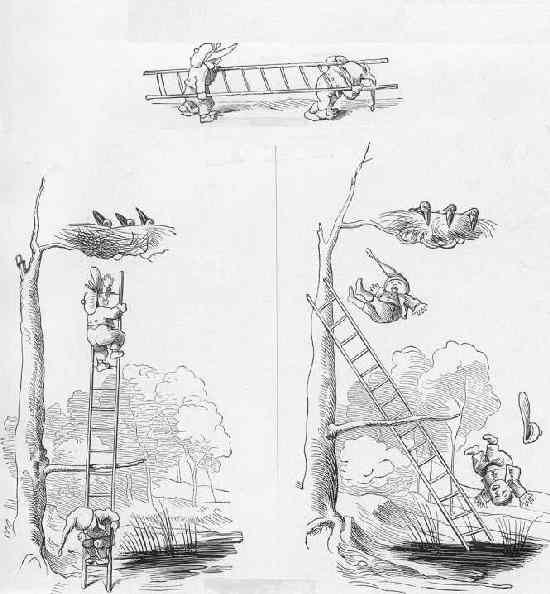
Figure 1.--This is a sample of Busch's slap-stick cartoon panes, the first comic strips. He normally added humerous verses to his comic strips. "The raven's nest" is about the two boys who wanted to climb up to the nest and harm the 3 little ravens.


Figure 1.--This is a sample of Busch's slap-stick cartoon panes, the first comic strips. He normally added humerous verses to his comic strips. "The raven's nest" is about the two boys who wanted to climb up to the nest and harm the 3 little ravens. |
I had always thought that the comic strip was an American creation, but it is the German illustrator and humerous poet that apparently is created weith inventing the comic strip. Wilhelm Busch was born in 1832, in the village of Wiedensahl near Hanover, Germany.
His goal was to be a master painter, but instead his career took a very different path. His career, however, took a very different course. A popular German satirical magazine Fliegende Blaetter asked him to do some caricatures. The drawings proved popular and Busch began adding his own humorous verses. Gradually his cartoons grew longer and were done in elaborate multiple panes--thus they can be called the frst comic strips. The public loved his lively characters and slap-stick humor. It was for his fanciful verse, however, that he is best known in Germany. His two most famous charcters were two little boys, Max and Moritz.
His father was a cheerful and hard working shopkeeper. His mother was quiet and pious home maker. She was industrious and kept a garden. They created a loving, comfortable home for their son Wilhelm.
Wilhelm was born in 1832, in the village of Wiedensahl near Hannover. It was located in Lower Saxony. He grew up in a Germany that was not not yet united. He had an older brother. Wilhelm at age 7-8 remembers getting up early in the morning and while his mother and grandmother prepared breakfast, copied out songs from a song book. There is a detailed biography on Busch available, but I can't make out much of the German.
Wilhelm Busch was a painter, early cartoonist, and a dearly beloved German poets.
As a boy he dreamed if being a great master painter. He particularly loved the the great Dutch and Flemish masters like Brouwer, Hals, Ostade, and Rubens. His career, however, took a very different course. A popular German satirical magazine Fliegende Blaetter asked him to do some caricatures. Fliegende Blaetter was founded in Munish about 1848. The drawings proved popular and Busch began adding his own humorous verses. Gradually his cartoons grew longer and were done in elaborate multiple panes--thus they can be called the frst comic strips. I'm not sure what the German term for comic strip is. The public loved his lively characters and slap-stick humor. It was for his fanciful verse, however, that he is best known in Germany. His two most famous charcters were two little boys, Max and Moritz. A museum in Hanover honors his memory and has many exhibitions on caricature and critical drawing.
Busch's cartoons are wonderfully whimsical with delightful slap-stick humor. They would have been inventive and highly original in the mid-19th century.
Busch also wroter children's books. One such book was Hans Huckebein illustrated with his drawings of course. It was divided into four parts because it was first published serailly in Die illustrierte Welt (1867).
Busch became renowned in Germany for his verse. He never married, remaining a bachelor his entire life. He disliked all the public attention that came with his fame. The newspapers referred to him as the "Hermit of Wiedensahl". He died in 1908.
Wilhelm had two cousind by the same name. One also became an illustrator.
Wilhelm was born in 1897. He served as a young second lieutenant in World War I, experiencing the horrors of World War I. He became a committed Christain during the War and afterwards studied theology, becoming a minioster in the 1920s. He became associated with the Essener of youth club (later called Weigle House) in 1930 as a youth minister. After the NAZI take over in 193 he was repeatedly arrested by the Gestapo because he refused the loyalty oath to Adolf Hitler. Nevertheless he found ways to continue its youth work duringbthe Third Reich. After World War II (1939-45) he continued youth work until retiring in 1962. He died during 1966 it died in Luebeck. He published many books with lectures, devotions and narrations. Its best-known book is Jesus Our Fate.
Wilhelm M. Busch was born on Sept. 1st 1908 in Breslau as the son of the painter Arnold Busch, who taught at the Breslau Art Academy.
He got his intermediate hight school certificate and completed a 3-year
course as a decorative painter. He studied from 1929 till 1932 at the
Berlin Academy of Free and Applied Arts and became a press draftsman.
During World War he was drafted as a [?P.K.]-illustrator.
He settled in Blankenese in 1954 and was occupied with a teaching job at the Textile & Fashion School (later Academy for Design) in Hamburg. 1984 he was appointed Professor by the Hamburg Senate. On July 7 1987 he died of a weak heart. Wilhelm M. Busch became known especially as an illustrator of more than 300 books.
The charcters in Busch's drawings are rather plainly drawn. Also they are often imaginative. Thus while Busch is a wonderful poet and cartoonist, his drawings do not provide us with much interesting fashion information.
Navigate the Boys' Historical Clothing Artist pages:
[Return to the Main individual illustrator page]
[Chronology]
[Countries]
[Individuals]
[Styles]
Navigate the Boys' Historical Clothing Web Site:
[Introduction]
[Activities]
[Biographies]
[Chronology]
[Clothing styles]
[Countries]
[Literary]
[Bibliographies]
[Contributions]
[FAQs]
[Glossaries]
[Satellite sites]
[Tools]
[Boys' Clothing Home]
